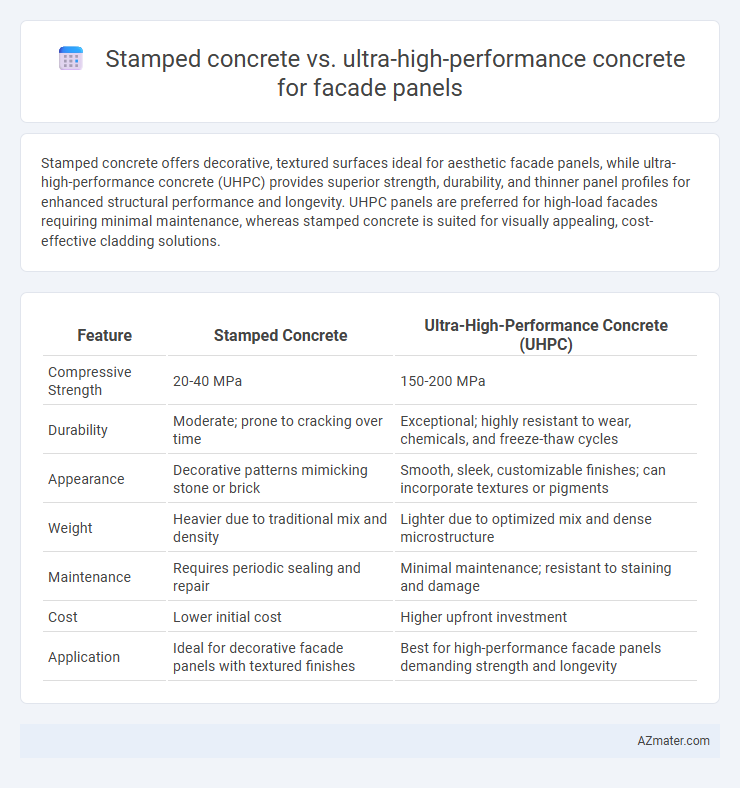Stamped concrete offers decorative, textured surfaces ideal for aesthetic facade panels, while ultra-high-performance concrete (UHPC) provides superior strength, durability, and thinner panel profiles for enhanced structural performance and longevity. UHPC panels are preferred for high-load facades requiring minimal maintenance, whereas stamped concrete is suited for visually appealing, cost-effective cladding solutions.
Table of Comparison
| Feature | Stamped Concrete | Ultra-High-Performance Concrete (UHPC) |
|---|---|---|
| Compressive Strength | 20-40 MPa | 150-200 MPa |
| Durability | Moderate; prone to cracking over time | Exceptional; highly resistant to wear, chemicals, and freeze-thaw cycles |
| Appearance | Decorative patterns mimicking stone or brick | Smooth, sleek, customizable finishes; can incorporate textures or pigments |
| Weight | Heavier due to traditional mix and density | Lighter due to optimized mix and dense microstructure |
| Maintenance | Requires periodic sealing and repair | Minimal maintenance; resistant to staining and damage |
| Cost | Lower initial cost | Higher upfront investment |
| Application | Ideal for decorative facade panels with textured finishes | Best for high-performance facade panels demanding strength and longevity |
Introduction to Stamped Concrete and UHPC Facade Panels
Stamped concrete offers a decorative surface mimicking materials like brick, stone, or tile, providing aesthetic versatility and cost-effective facade solutions. Ultra-high-performance concrete (UHPC) facade panels deliver superior strength, durability, and enhanced resistance to environmental stresses, making them ideal for long-lasting architectural applications. Both materials cater to differing project needs, with stamped concrete prioritizing visual appeal and UHPC focusing on structural performance.
Composition and Material Properties
Stamped concrete consists of a blend of Portland cement, aggregates, and coloring agents designed to mimic natural materials, offering moderate compressive strength and aesthetic versatility for facade panels. Ultra-high-performance concrete (UHPC) incorporates fine powders, high cement content, silica fume, superplasticizers, and steel fibers, resulting in exceptional compressive strength exceeding 150 MPa, superior durability, and enhanced tensile properties. The dense microstructure of UHPC minimizes porosity and ensures high resistance to environmental degradation compared to the more porous and less durable stamped concrete.
Aesthetic Flexibility: Design and Finishes
Stamped concrete offers extensive aesthetic flexibility with customizable patterns, textures, and colors that mimic natural materials like stone and wood, making it ideal for decorative facade panels. Ultra-high-performance concrete (UHPC) allows for sleek, thin, and intricately detailed finishes with superior surface smoothness and durability, enabling innovative modern designs and complex geometries in facade applications. Both materials provide unique design advantages, but UHPC excels in achieving high precision and minimalist aesthetics, while stamped concrete delivers versatile, traditional, and textured visual effects.
Structural Performance and Durability
Stamped concrete offers moderate structural performance with enhanced aesthetic versatility but may face limitations in load-bearing capacity and long-term durability under harsh environmental conditions. Ultra-high-performance concrete (UHPC) exhibits superior structural strength, exceptional tensile capacity, and enhanced durability due to its dense microstructure and fiber reinforcement, making it highly resistant to freeze-thaw cycles, corrosion, and abrasion for facade panels. The longevity and minimal maintenance requirements of UHPC panels often make them a more cost-effective and resilient choice for demanding architectural applications.
Thermal and Insulation Capabilities
Stampled concrete facade panels offer moderate thermal insulation due to their dense structure that retains heat but require additional insulating materials for enhanced energy efficiency. Ultra-high-performance concrete (UHPC) provides superior thermal resistance and low thermal conductivity, making it ideal for facade panels that demand high insulation performance and durability. UHPC's fine microstructure reduces heat transfer, significantly improving energy conservation and indoor climate control compared to traditional stamped concrete.
Installation Techniques and Construction Process
Stamped concrete offers faster installation with conventional casting methods and customizable surface patterns, making it ideal for aesthetic facade panels requiring texture and color variety. Ultra-high-performance concrete (UHPC) requires specialized formwork, mixing, and curing processes due to its dense matrix and fine aggregates, ensuring superior strength and durability but increasing construction complexity. The choice between stamped concrete and UHPC involves balancing ease of installation with performance demands for facade panel applications.
Maintenance Requirements and Longevity
Stamped concrete facade panels require regular sealing and cleaning to prevent surface wear and discoloration, with a typical lifespan of 10 to 20 years under normal conditions. Ultra-high-performance concrete (UHPC) panels offer superior durability and resistance to environmental stressors, minimizing maintenance needs and extending service life beyond 50 years. The high compressive strength and low permeability of UHPC significantly reduce the risk of cracking and weathering compared to stamped concrete, making it a more cost-effective solution over time.
Cost Considerations and Lifecycle Value
Stamped concrete typically offers lower initial costs for facade panels due to simpler materials and installation processes, making it an attractive choice for budget-sensitive projects. Ultra-high-performance concrete (UHPC) commands higher upfront expenses driven by specialized materials and labor but delivers greater durability, reduced maintenance, and enhanced resistance to environmental factors, resulting in superior lifecycle value. Lifecycle cost analysis often favors UHPC for long-term investments, as its extended service life and minimal repair requirements offset initial premium costs over time.
Sustainable and Environmental Impacts
Stamped concrete offers a visually appealing, cost-effective facade solution with moderate environmental impact due to its reliance on traditional Portland cement, which contributes to CO2 emissions. Ultra-high-performance concrete (UHPC) boasts superior durability and reduced permeability, significantly extending the lifespan of facade panels and lowering lifecycle environmental impacts through decreased maintenance and repair needs. UHPC's potential for incorporating industrial byproducts and its enhanced structural efficiency make it a more sustainable choice for facade applications compared to stamped concrete.
Choosing the Right Material for Your Facade Panel Project
Stamped concrete offers aesthetic versatility and cost-effectiveness, ideal for facade panels requiring decorative patterns and textures. Ultra-high-performance concrete (UHPC) provides superior strength, durability, and enhanced resistance to environmental factors, making it suitable for high-performance architectural facades. Selecting the right material depends on project priorities such as budget, design complexity, structural requirements, and long-term maintenance considerations.

Infographic: Stamped concrete vs Ultra-high-performance concrete for Facade panel
 azmater.com
azmater.com